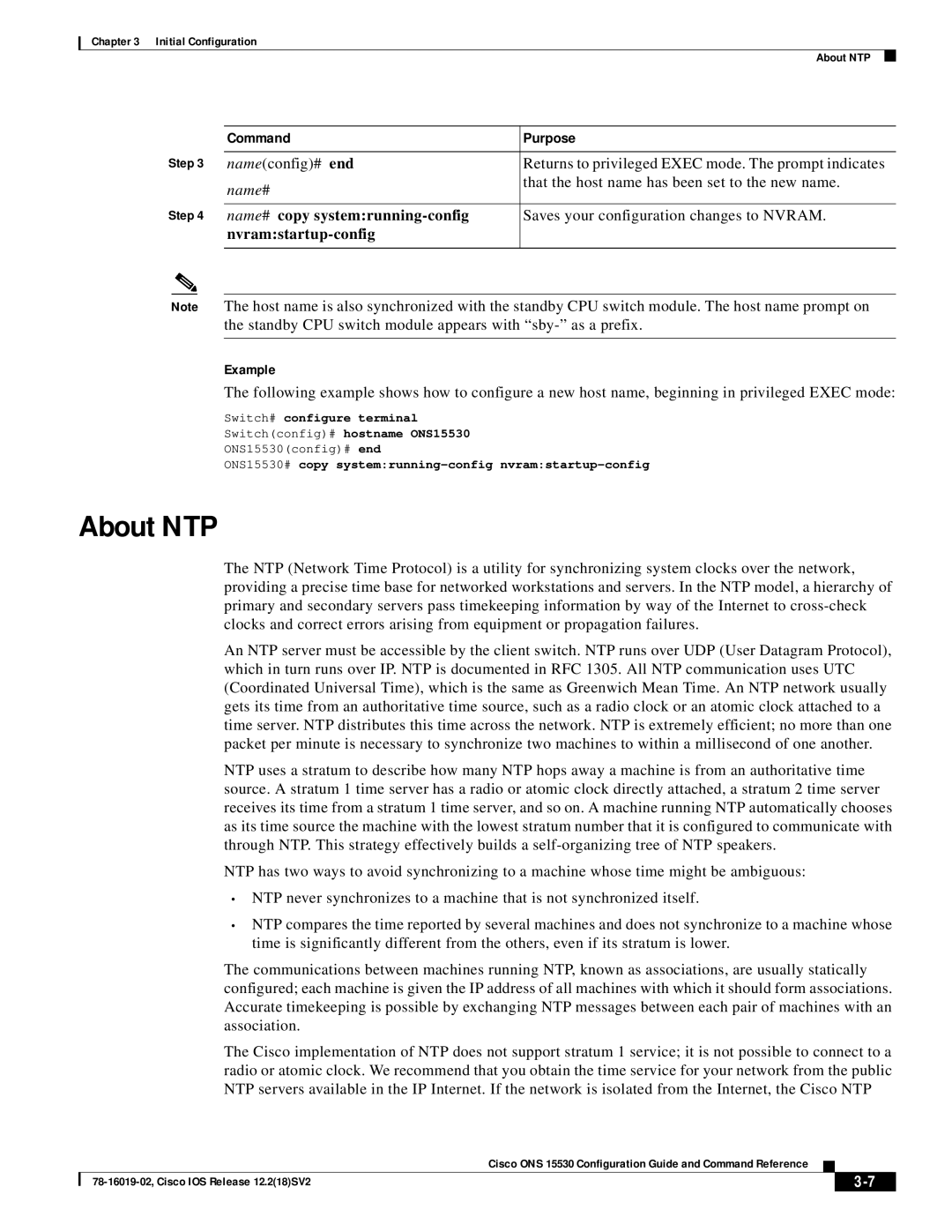
Chapter 3 Initial Configuration
|
| About NTP |
|
|
|
| |
| Command | Purpose | |
Step 3 |
|
| |
name(config)# end | Returns to privileged EXEC mode. The prompt indicates | ||
| name# | that the host name has been set to the new name. | |
|
|
| |
Step 4 |
|
| |
name# copy | Saves your configuration changes to NVRAM. | ||
|
|
| |
|
|
|
|
Note The host name is also synchronized with the standby CPU switch module. The host name prompt on the standby CPU switch module appears with
Example
The following example shows how to configure a new host name, beginning in privileged EXEC mode:
Switch# configure terminal
Switch(config)# hostname ONS15530
ONS15530(config)# end
ONS15530# copy system:running-config nvram:startup-config
About NTP
The NTP (Network Time Protocol) is a utility for synchronizing system clocks over the network, providing a precise time base for networked workstations and servers. In the NTP model, a hierarchy of primary and secondary servers pass timekeeping information by way of the Internet to
An NTP server must be accessible by the client switch. NTP runs over UDP (User Datagram Protocol), which in turn runs over IP. NTP is documented in RFC 1305. All NTP communication uses UTC (Coordinated Universal Time), which is the same as Greenwich Mean Time. An NTP network usually gets its time from an authoritative time source, such as a radio clock or an atomic clock attached to a time server. NTP distributes this time across the network. NTP is extremely efficient; no more than one packet per minute is necessary to synchronize two machines to within a millisecond of one another.
NTP uses a stratum to describe how many NTP hops away a machine is from an authoritative time source. A stratum 1 time server has a radio or atomic clock directly attached, a stratum 2 time server receives its time from a stratum 1 time server, and so on. A machine running NTP automatically chooses as its time source the machine with the lowest stratum number that it is configured to communicate with through NTP. This strategy effectively builds a
NTP has two ways to avoid synchronizing to a machine whose time might be ambiguous:
•NTP never synchronizes to a machine that is not synchronized itself.
•NTP compares the time reported by several machines and does not synchronize to a machine whose time is significantly different from the others, even if its stratum is lower.
The communications between machines running NTP, known as associations, are usually statically configured; each machine is given the IP address of all machines with which it should form associations. Accurate timekeeping is possible by exchanging NTP messages between each pair of machines with an association.
The Cisco implementation of NTP does not support stratum 1 service; it is not possible to connect to a radio or atomic clock. We recommend that you obtain the time service for your network from the public NTP servers available in the IP Internet. If the network is isolated from the Internet, the Cisco NTP
|
| Cisco ONS 15530 Configuration Guide and Command Reference |
|
| ||
|
|
| ||||
|
|
|
| |||
|
|
|
| |||
